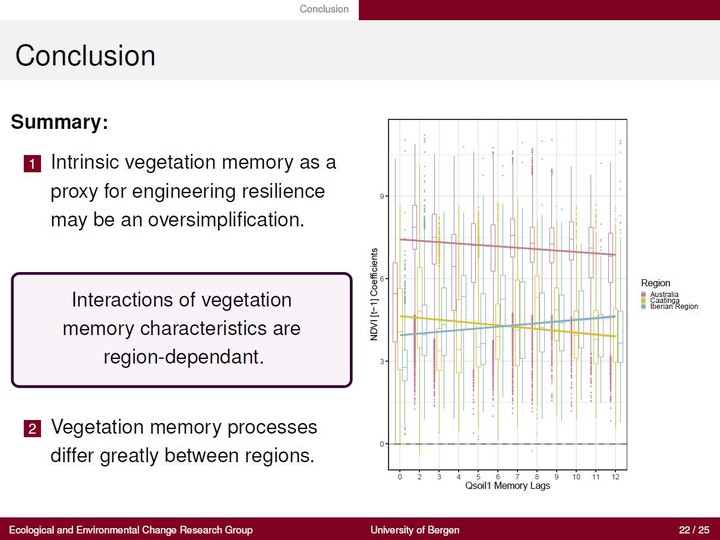Inferring Vegetation Memory from Remote Sensing Data using novel Climate Reconstruction Products

Abstract
The dependence of humans on stable, intact ecosystems has lead to an increasing appreciation of the need for resilience goals to be incorporated into environmental policy catalogues. Remote sensing has played a key role in mapping vegetation sensitivity, resistance and resilience at a global scale. Within these studies, vegetation memory has been used as an important proxy for ecosystem recovery rates, potentially a key component of vegetation resilience. In particular, strong vegetation memory effects have been identified in dryland regions coinciding with decreased vegetation sensitivity towards climatological drivers. However, vegetation memory has been identified to be more than straightforward assessments of recovery rates. A recent approach by Ogle et al. distinguishes intrinsic and extrinsic vegetation memory components. Here, I aim to test the components and drivers of vegetation memory in dryland regions using state-of-the-art climate reanalysis data and refined approaches to identifying vegetation memory characteristics. This has lead to novel insights into spatial patterns of vegetation memory characteristics across three distinct predominantly dryland regions (Iberian Region, Caatinga, and Australia). My thesis shows that (1) dryland regions are characterised by strong intrinsic vegetation memory as well as strong extrinsic vegetation memory, (2) it is possible to distinguish intrinsic and extrinsic vegetation memory to a hitherto unachieved degree using climate reanalysis data sets, and (3) dryland vegetation does not react to bioclimatic forcing in the same way across the Earth. In addition, this thesis aims to link the spatial patterns of vegetation memory with functional ecology datasets (i.e. TRY and COMPADRE). This is done to establish connections between plant life history strategies and vegetation memory characteristics thereby identifying causal pathways enabling vegetation memory. I based my hypotheses on the concept of information and material legacies by Johnstone et al. Regarding information legacies, I expected any life history strategy allowing plants to regenerate quickly to bioclimatic events to result in shorter recovery rates and lower vegetation memory. Material legacies, such as the ones identified via plant functional traits of leaf nitrogen content or vegetative height, I postulated to enable both resistance as well as recovery from perturbation events. My analyses did not find any support for the latter statement but did identify biological first time-step response of populations towards perturbations as well as plant reproductive strategy to be related to vegetation memory capabilities. Thus, my study presents a synthesis of resilience thinking, vegetation memory modelling approaches, climate science, and functional ecology. My findings demonstrate novel observations of vegetation memory patterns across dryland regions such as regional differences of processes forming vegetation memory capabilities. Consequently, this study provides a helpful stepping stone for refining and combining already existing methodology which could, in turn, generate important knowledge of ecosystem functioning and resilience.